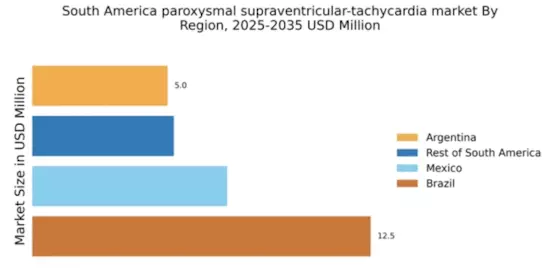Advancements in Diagnostic Technologies
Advancements in diagnostic technologies are significantly influencing the paroxysmal supraventricular-tachycardia market. The introduction of innovative diagnostic tools, such as portable ECG monitors and advanced imaging techniques, has improved the accuracy and speed of PSVT diagnosis. These technologies enable healthcare professionals to identify PSVT episodes more effectively, leading to timely interventions. In South America, the market for diagnostic devices is projected to grow at a CAGR of 8% over the next five years, reflecting the increasing demand for precise diagnostic solutions. As healthcare systems invest in modernizing their diagnostic capabilities, the paroxysmal supraventricular-tachycardia market is likely to benefit from enhanced patient management and treatment strategies.
Increased Focus on Preventive Healthcare
An increased focus on preventive healthcare is emerging as a significant driver for the paroxysmal supraventricular-tachycardia market. As awareness of cardiovascular health grows, more individuals are seeking preventive measures to mitigate the risk of developing PSVT. Health campaigns and educational programs aimed at promoting heart health are becoming more prevalent in South America. This shift towards prevention is likely to result in earlier detection and management of PSVT, ultimately leading to a larger patient base seeking treatment. The paroxysmal supraventricular-tachycardia market may experience growth as healthcare providers adapt their services to cater to this proactive approach, emphasizing the importance of regular check-ups and lifestyle modifications.
Increasing Incidence of Cardiac Disorders
The rising incidence of cardiac disorders in South America is a crucial driver for the paroxysmal supraventricular-tachycardia market. As lifestyle changes and urbanization contribute to higher rates of obesity, hypertension, and diabetes, the prevalence of paroxysmal supraventricular tachycardia (PSVT) is likely to increase. Recent studies indicate that approximately 1.5 million individuals in South America are affected by PSVT, which underscores the urgent need for effective treatment options. This growing patient population is expected to drive demand for innovative therapies and medical devices, thereby propelling the paroxysmal supraventricular-tachycardia market forward. Furthermore, healthcare providers are increasingly recognizing the importance of early diagnosis and management of PSVT, which may lead to enhanced patient outcomes and increased market growth.
Growing Investment in Healthcare Infrastructure
The growing investment in healthcare infrastructure across South America is a pivotal driver for the paroxysmal supraventricular-tachycardia market. Governments and private entities are increasingly allocating funds to improve healthcare facilities, which includes the establishment of specialized cardiac care units. This trend is expected to enhance access to advanced treatment options for patients suffering from PSVT. For instance, Brazil has seen a 15% increase in healthcare spending in recent years, which is likely to facilitate the adoption of new therapies and technologies in the paroxysmal supraventricular-tachycardia market. Improved infrastructure not only supports better patient care but also encourages research and development initiatives, further stimulating market growth.
Rising Demand for Minimally Invasive Procedures
The rising demand for minimally invasive procedures is reshaping the paroxysmal supraventricular-tachycardia market. Patients are increasingly favoring treatments that offer reduced recovery times and lower risks of complications. Techniques such as catheter ablation have gained popularity due to their effectiveness in managing PSVT with minimal discomfort. In South America, the market for minimally invasive cardiac procedures is anticipated to expand by 10% annually, driven by patient preferences and advancements in technology. This shift towards less invasive treatment options is likely to enhance the paroxysmal supraventricular-tachycardia market, as healthcare providers adopt these methods to meet patient expectations and improve clinical outcomes.


















Leave a Comment